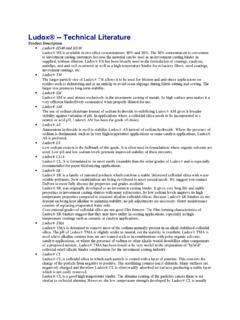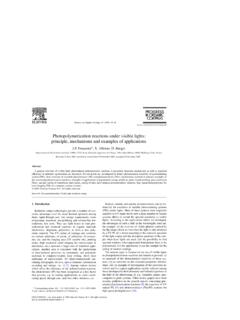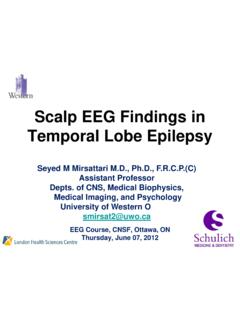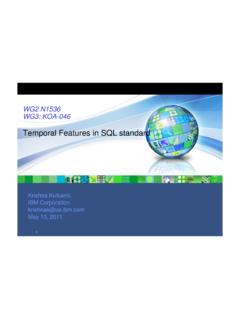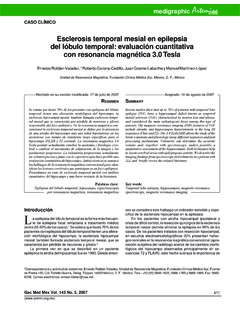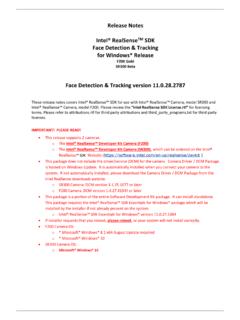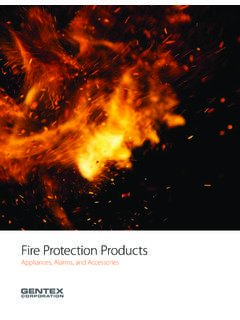Transcription of Quantification of Quaternary Mixtures of Low Alcohols in ...
1 Anal. Chem. 2005, 77, 5542-5550. Quantification of Quaternary Mixtures of Low Alcohols in Water: temporal - resolved Measurements with microporous and hyperbranched Polymer Sensors for Reduction of Sensor Number 1 nter Gauglitz, . Matthias Vollprecht, Frank Dieterle, Stefan Busche,*, Gu . Klaus-Jochen Eichhorn, and Brigitte Voit . Institute of Physical and Theoretical Chemistry, University of Tu bingen, Auf der Morgenstelle 8, 72076 Tu bingen, Germany, and Institute of Polymer Research Dresden , Hohe Strasse 6, 01069 Dresden, Germany The focus of this study is the Quantification of multianalyte Because a sensory approach is not based on a separation effect, Mixtures in water by the use of sensor arrays based on such as GC or HPLC, the Quantification of a multianalyte mixture polymer layers.
2 Reflectometric interference spectroscopy requires a sensor array with polymer films of different sensitivities. is used as a optical sensor system for temporal - resolved For the calibration of such a sensor array, usually only one single measurements of the interaction kinetics of analytes in property per sensor signal, for example, the area, the slope at a water with the polymer layers. The principles and wide- certain time point, or the height at equilibrium, is used for data spread possibilities of this approach are demonstrated analysis. By evaluating the sensor response with model-based using the Quantification of Quaternary aqueous Mixtures multivariate methods or artificial neural networks, a qualification of low Alcohols from methanol up to 1-butanol.
3 The and Quantification of analytes in Mixtures is The main sensitive layers consist of two hyperbranched polyesters drawback of this widespread approach is that the multivariate and one microporous polyimide. Different time-dependent calibration methods for the Quantification of multiple analytes in sensor signals are evaluated by artificial neural networks. Mixtures need as many sensor signals and sensors as analytes to Because the kinetics of sorption and desorption of the be quantified; otherwise, the system would be statistically under- analytes differ significantly, the number of sensors needed determined.
4 This renders the array approach hardware- and cost- for a Quantification of analytes in Mixtures can be reduced. intensive for many applications. A feature extraction allows identification of the most In contrast to such static sensor measurements, a very recent important differences of kinetic patterns of the analytes trend in sensor research is the exploitation of the interaction and allows improvement of the multivariate calibration. kinetics of a sensor with different analytes by the use of temporal - It is shown that a Quantification of Quaternary Mixtures resolved measurements.
5 If various analytes of a mixture show of methanol, ethanol, 1-propanol, and 1-butanol is pos- different kinetics for the sorption into sensitive polymer layers sible on the basis of only two polymer sensors. due to different size or polarity of these analytes, the resulting sensor response differs in shape for all analytes. If such sensors The Quantification of multianalyte Mixtures in gas or liquid are combined with multivariate data analysis techniques, such as phases is of great interest. An efficient protection of air and water artificial neural networks, the number of analytes quantified per requires powerful analytical tools for sites exposed to pollution.
6 Sensor is limited only by the similarity of interaction kinetics. A. For this purpose, most of the common analytical methods require virtual sensor array is created, and the number of sensors a time- and money-consuming sampling on-site followed by a necessary for the Quantification can be reduced. transfer of the samples to a laboratory. In the past decade, optical The investigation of such temporal - resolved approaches in gas sensors have been established as new and useful tools for the and liquid phases have been reported by several By real-time detection and Quantification of environmentally relevant temporal - resolved measurements with an array of quartz microbal- compounds or of Mixtures on-line or even in-line in the environ- (2) Wolfbeis, O.
7 S. Anal. Chem. 2002, 74, 2663-2678. ment. These sensing devices enable fast, reproducible, long-term, (3) Doleman, B. J.; Lonergan, M. C.; Severin, E. J.; Vaid, T. P.; Lewis, N. S. and inexpensive monitoring. Many of different applications for Anal. Chem. 1998, 70, 4177-4190. (4) Park, J.; Groves, W. A.; Zellers, E. T. Anal. Chem. 1999, 71, 3877-3886. optical sensors have been reported in the ,2 (5) Seemann, J.; Rapp, F. R.; Zell, A.; Gauglitz, G. Fresenius' J. Anal. Chem. 1997, 359, 100-106. * Corresponding author. Phone: +49 (0) 7071/29-78760. Fax: +49 (0) 7071/ (6) Schaffer, R.
8 E.; Rose-Pehrsson, S. L.; McGill, R. A. Anal. Chim. Acta 1999, 29-5960. E-mail: 384, 305-317.. University of Tu bingen. (7) Hierlemann, A.; Weimar, U.; Kraus, G.; Gauglitz, G.; Go pel, W. Sens. Mater.. Institute of Polymer Research Dresden 1995, 7, 179-189. (1) Janata, J.; Josowicz, M. Anal. Chem. 1998, 70, 179-208. (8) Grate, Y. W.; Wise, B. M. Anal. Chem. 2001, 73, 2239-2344. 5542 Analytical Chemistry, Vol. 77, No. 17, September 1, 2005 CCC: $ 2005 American Chemical Society Published on Web 08/09/2005. ances coated with three different polymer films, six solvent vapors ibility with other polymers; and much stronger interactions with could be Even single-sensor approaches in the gas solvents, organic molecules, and other polymers in general.
9 The phase have been performed. The Quantification of a binary mixture thermal, mechanical, and the dynamic properties of the polymers of Alcohols or refrigerants was performed by the use of a surface are governed mainly by the nature of the end groups and not by plasmon resonance (SPR) device on the basis of measurements the structure of the repeating units of the backbone. An overview in a temporal - resolved ,16 Two single-sensor setups for the of different applications of such polymer systems has been given Quantification of Quaternary Mixtures of Alcohols in the gas phase by Gao and The suitability of hyperbranched polymers for were reported by Kasper et Binary and ternary Mixtures of gas and solution separations is presented in several organic analytes in water were determined by one single ampero- A polymeric molecular filter for chemical sensors consisting of metric.
10 19 A static reflectometric interference sensor was hyperbranched films and -cyclodextrin receptors was reported used for the Quantification of binary Mixtures of low Alcohols in by Dermody et hyperbranched polyesters have been formerly So far, no temporal - resolved measurements have been applied as sensor materials for the Quantification of single analytes performed in the liquid phase on the basis of polymer sensors. in the gas In this study, the simultaneous Quantification of methanol, In this work, it is shown that the combination of one or two ethanol, 1-propanol, and 1-butanol in a Quaternary mixture in water hyperbranched polymers as sensitive layers, one microporous is presented.
